August 2003
Where the Sidewalk Ends
A paper in the September issue of the American Journal of Public Health, “Promoting Safe Walking and Cycling to Improve Public Health: Lessons From The Netherlands and Germany” by a couple of researchers in New Jersey and Brussels examines:
“The public health consequences of unsafe and inconvenient walking and bicycling conditions in American cities to suggest improvements based on successful policies in The Netherlands and Germany.”
What they found:
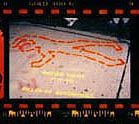 “Cyclists and pedestrians in the United States were two to six times more likely to be killed than their German or Dutch counterparts. Per kilometer traveled, U.S. pedestrians were 23 times more likely to get killed than the occupants of a car, while bicyclists were 12 times more likely to be killed.” [source]
“Cyclists and pedestrians in the United States were two to six times more likely to be killed than their German or Dutch counterparts. Per kilometer traveled, U.S. pedestrians were 23 times more likely to get killed than the occupants of a car, while bicyclists were 12 times more likely to be killed.” [source]
With this in mind and my previous post on the link between sprawl and obesity, I note that on July 24, the House Appropriations Committee voted a transportation appropriations bill out of committee that eliminates funding for the Transportation Enhancements program.
Since 1991, 10% of federal funds distributed to states through the Surface Transportation Program has been reserved for transportation enhancement activities. This meant roughly $600 million a year of federal funding for locally driven, pedestrian centered projects.
“Congress established the TE program in 1991 as a commitment by Congress to constituents that a small percentage of their gas tax dollars would be targeted to small-scale, community-initiated, locally selected transportation projects such as multi-use paths, pedestrian and bicycle facilities, historic preservation, and improvement of streetscapes and landscapes.” [source]
“Since its inception, the TE program has provided $6 billion to support 16,699 projects nationwide, including thousands of historic preservation projects. Now, Congress is acting to reverse this decade-long community building program and return to a regressive ‘roads-only’ policy.” [source]
The Rails-to-Trails Conservancy has posted a detailed state-level breakdown of projects funded under Transportation Enhancements program.
H.R. 2989, the Transportation and Treasury Appropriations Bill for 2004, actually increases highway spending to $34.1 billion — $6.1 billion more than 2003 and $4.5 billion more than President Bush’s request.
There is still hope, but we must act now. Before the full House votes on the bill it can still be amended. Congress resumes after Labor Day and is expected to vote on the bill in early September.
An amendment removing section 114 from H.R. 2989 would grant approximately $812 million to the Transportation Enhancements program. Unless reversed, individual states would be allowed to put all funds into highway projects instead of setting aside the 10% now reserved for bicycle and pedestrian projects.
See these action alerts to learn more, for contact information and talking points.
With all that’s going on, the issue is probably not high on everyone’s social justice agenda. But there’s an immediate and brief opportunity to save this great program right now.
UPDATE: On September 4 the House approved an amendment which strikes section 114 from the bill — restoring funding for the Transportation Enhancements program to the appropriations bill. On September 9, the House passed the full appropriations bill and sent it to the Senate. Thanks to everyone for taking action!
Sprawl Linked to Obesity
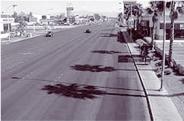 From the press release:
From the press release:
“A new national study and special issues of two prestigious medical journals released today offer powerful indications that sprawling development has a hand in the country’s obesity crisis. Together, they demonstrate the urgent need to invest in making America’s neighborhoods appealing and safe places to walk and bicycle. The peer-reviewed study, which used a county sprawl index developed in partnership with Smart Growth America, found that people living in automobile-dependent neighborhoods that suppress walking do indeed walk less, weigh more, and are more likely to suffer from high blood pressure. The study, Relationship between Urban Sprawl and Physical Activity, Obesity, and Morbidity is being published in a special issue of the American Journal of Health Promotion. Smart Growth America and the Surface Transportation Policy Project have issued a companion report, Measuring the Health Effects of Sprawl, which gives county-level data illustrating the findings for the metropolitan areas studied. In most metropolitan areas, residents in more sprawling counties are heavier and face higher odds of being obese and having high blood pressure than those in less sprawling counties... The report outlines seven steps communities can take to respond to the findings of the research.”
The paper was presented at the 11th annual Congress for the New Urbanism, an organization that pushes for all new development in the United States to be more compact and walkable.
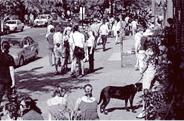 The metropolitan sprawl index:
The metropolitan sprawl index:
“uses 22 variables to characterize four ‘factors’ of sprawl for 83 of the largest metropolitan area in the US for the year 2000. The sprawl ‘scores’ for each metropolitan area show how much they spread out housing, segregate homes from other places, have only weak centers of activity, and have poorly connected street networks.... The county sprawl index uses six variables from the US Census and the Department of Agriculture’s Natural Resources Inventory to account for residential density and street accessibility.”
The sprawl index of 448 counties was compared to body mass index and data on average weight drawn from the Centers for Disease Control and Prevention.
Research into other factors, such as linking location to what and how much people eat, and analysis at the neighborhood level is forthcoming.
Obesity in the United States is at an all time high. More than two-thirds of adults are overweight and nearly 1 in 3 are obese. Obesity is rapidly catching up to tobacco use as the leading cause of death. [source]
via Planetizen
Designing for the Dispossessed
From The New York Times, August 28, 2003:
“Designing for the Dispossessed
by Alastair Gordon
At age 29, Cameron Sinclair was among the youngest speakers at the International Design Conference in Aspen, Colo., last week. He nonetheless brought a full auditorium to its feet Thursday morning with a review of his work with Architecture for Humanity, a nonprofit organization he started from his Manhattan studio apartment with a scattering of volunteers and a shoestring budget.
Over the last four years, Mr. Sinclair’s group has helped generate programs and designs for disaster relief in 20 countries, including Afghanistan, Kosovo and South Africa.
Mr. Sinclair’s talk, peppered with well-rehearsed lines (‘All I ask is that they design like they give a damn’) was tailor-made for a design conference that took global concerns with safety as its theme.
‘He has been a mainstay and hero of the conference,’ said Paola Antonelli, a curator at the Museum of Modern Art in New York and a chairwoman of the conference. ‘He’s asking architects to take a risk and forget about immediate profits.’
Mr. Sinclair’s appearance alongside more established design figures is evidence of a shift, particularly among students and younger designers, toward social responsibility.
‘Would someone like me have been invited to speak here five years ago?’ Mr. Sinclair said. ‘Probably not. But a lot of younger architects don’t want to design doorknobs in boutique hotels anymore. They want to be engaged, they want to help find solutions to critical problems.’
Of course, Mr. Sinclair is not the only one generating designs for relief. The Rural Studio, based in Auburn, Ala., has helped provide housing for the rural poor since 1993, and Shelter for Life, a volunteer group based in Oshkosh, Wis., has built houses in Afghanistan. But through persistence, personal charm and a marriage to a journalist who writes press releases and grant proposals, Mr. Sinclair has managed to make himself the center of a global network of designers, engineers and relief groups.
Mr. Sinclair and his wife, Kate Stohr, 29, have gone a long way with limited means. He was laid off from his job as a project architect at Gensler a year ago, and has devoted himself to Architecture for Humanity full time ever since. ‘Here we are doing health programs around the world,’ he said. ‘And we can’t afford health insurance for ourselves.’
Four days after 9/11, the United Nations High Commission for Refugees called Mr. Sinclair, he said, to tell him he was on a list of people that could be asked to help with the coming relief effort in Afghanistan. ‘I told them I hope it’s a long list,’ he said, ‘because I’m a 28-year-old alone in my apartment.’ (He put them in contact with architects and engineers in Pakistan and other neighboring countries.)
During the 1960’s and early 70’s, young architects as a rule felt almost obliged to address issues like affordable housing and community planning. But by the time Mr. Cameron arrived at the Bartlett School of Architecture in London in the late 1990’s, these concerns had given way to a preoccupation with signature design and theory.
‘I was the black sheep of my class,’ said Mr. Sinclair, who designed housing for the homeless as his thesis project. ‘My fellow students were more interested in getting into Wallpaper magazine.’
He does not feel like a black sheep anymore. In the past two months, more than 120 people have applied to work for him as unpaid interns, most of whom had to be turned away.
‘A lot of my generation is disillusioned,’ Mr. Sinclair said.
‘You finish school, start with a big firm, and become a CAD monkey working in a little cubicle,’ he added, referring to computer-animated design. ‘You’re told that only one out of a hundred will make it as a name architect. That’s depressing.’
Mr. Sinclair, who was raised in London, showed his organizational knack two years ago when he founded the ‘Uncoordinated Soccer League’ in New York for unathletic designers, a dozen of whom ended up volunteering for his group.
In 1999, with a budget of just $700, Mr. Cameron held a competition to design transitional housing for refugees returning to Kosovo. He received nearly 300 entries from 30 countries, including a modern yurt built around a central column by the Oakland-based firm Basak Altan Design. ‘Refugee shelter is usually a last-minute, ad hoc affair with little in the way of advance planning,’ Mr. Sinclair said. His goal was to provide shelters where refugees could live for years while rebuilding homes.
The jury, which included the architects Tod Williams, Billie Tsien and Steven Holl, picked 10 winners. Five prototypes were built, including a structure made of paper by Shigeru Ban of Tokyo and a shipping container lined with plywood by the Australian architect Sean Godsell.
Gans & Jelacic, a firm in New York, built a prototype of their entry, a triangular structure that pops up from a container with the help of a standard car jack.
I-Beam Design, another New York firm, designed a shelter made from wooden shipping pallets. ‘We were looking for a simple solution and realized that supplies sent to disaster areas are often shipped on these pallets,’ said Azin Valy of I-Beam. ‘We wanted a universal system that a child could put together.’
Ms. Valy and her partner, Suzan Wines, built a prototype in an abandoned lot in the South Bronx. Within weeks, a homeless man had moved in; and a week after that, the city had torn it down.
For all his persuasive ways, Mr. Sinclair has so far failed to actually build anything in Kosovo. He is among the first to acknowledge the failure. ‘We architects enjoy a pat on the back, but unless you build it, it’s just an idea,’ he said.
However thoughtful they may be, designs intended for developing countries often fail to consider local conditions. Muslim countries, for example, typically require separate facilities for men and women. Steel shipping containers, used in several submissions, may, in fact, be unsuitable in tropical climates. And structures that are hard to assemble are of limited use when recipients are largely women, children and older men.
‘It’s important that architects consult with the beneficiaries, which seems obvious, but this doesn’t always occur,’ said Erin Mooney, deputy director of a project on displaced people for the Brookings Institution and Johns Hopkins University.
Gans & Jelacic were one of the few who went into the field. Deborah Gans attended the Refugee Studies Center at Oxford University while her partner, Matthew Jelacic, visited refugee camps in Bosnia. There, tents outside Sarajevo had collapsed under snowfall.
Mr. Sinclair and Ms. Stohr married while organizing the Kosovo competition, and they left shortly afterward for a monthlong honeymoon in South Africa. ‘The honeymoon lasted two days,’ Mr. Sinclair said. While his wife began reporting an article on a rape epidemic in South Africa, later published in The Pittsburgh Post-Gazette, Mr. Sinclair met with urban planners and visited shantytowns.
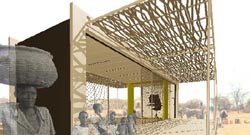 Two and a half years later, in May of 2002, Mr. Sinclair staged a competition for mobile medical clinics that could be used to treat AIDS in Africa. He received more than 530 submissions from 51 countries. (An exhibition of entries is touring five countries, ending with South Africa.)
Two and a half years later, in May of 2002, Mr. Sinclair staged a competition for mobile medical clinics that could be used to treat AIDS in Africa. He received more than 530 submissions from 51 countries. (An exhibition of entries is touring five countries, ending with South Africa.)
The proposal that won first place, by jury, is a self-sufficient clinic with a satellite dish, solar power and a water collection system. The clinic, designed by Khras Architects of Denmark, would be made from a lightweight metal skeleton with natural materials added for local texture.
‘Instead of one solution we wanted to come up with a system,’ said Mads Hansen, a member of the Khras team. ‘In Africa, especially in remote areas, you don’t just get a spare part from down the road.’
Mr. Sinclair is trying to raise $20,000 to send four finalists to meet with doctors and relief workers in South Africa before building prototypes.
‘Architects pride themselves on having a vision of the future, but in this case they’re not rising to the crisis,’ said Rodney Harber, an architect in Durban, South Africa, who has worked on AIDS-related projects for 10 years. ‘Cameron has made a real contribution. His competitions and Web site have helped to stimulate a global dialog.’
Mr. Sinclair and Ms. Stohr see their role over the next few years as advocates, shepherding their various projects to completion. ‘I’m hoping to one day watch the sun set in Africa while we sit on the porch of our mobile health clinic,’ Ms. Stohr said.”
Some interesting ideas in the mix. In 2002, I visited the church / community center built of cardboard tubes that Shigeru Ban constructed in Kobe after the horrible earthquake of 1995. It was still standing and very much in use.
The winning clinic is designed so it can be locally built, run, and maintained. The design criteria for the mobile clinic are as follows:
- The unit should adequately house, transport and be easily operable by a small team of medical professionals (2 to 5). Storage of equipment and medical supplies should be taken into consideration.
- The clinic should be cost-effective. If possible it should be built using sustainable materials and construction techniques. Designers can make use of either advanced or simple technologies and should look to take advantage of local materials, construction techniques and labor.
- The unit should be mobile and durable enough to be transported through widely diverse areas of Sub-Saharan Africa. Topography and terrain should be taken into account. Ease of maintenance and repair are essential.
- Entrants should take into consideration the tasks performed within the clinic. Although the unit will primarily be used for the prevention, testing and treatment of the virus and associated infections, it must also be a place where health care professionals can teach and disseminate information.
- In addition to HIV/AIDS, many other deadly but treatable diseases afflict the African continent, chief among them tuberculosis and malaria. The ideal design will take into account the varying health care needs of the population and should be easily adapted to treat these other diseases and conditions.
- One of the major obstacles is the stigma surrounding the disease and this should be taken into strong consideration when designing. If a clinic arrives into a remote area for the first time, think how it will be received into the community.
- Finally, the ideal design will also create opportunities for economic growth. Many of the regions deeply affected by HIV/AIDS have suffered economically to the point of reverse development. In addition to becoming a highly dispersed health care distribution network, designers are encouraged to pursue ways of providing complimentary or secondary services in addition to health care via the same mobile unit.
It’s great to see the power a couple of individuals can have to promote the design in the public interest.
Still, it’s unfortunate that it is so apolitical. Better treatment and a few more rural health clinics is a good thing, but clinic design does not address public health policy, or the economic, social, and cultural factors propelling the AIDS epidemic. There are plenty of clinics in the West, and yet the epidemic continues. I wonder if the Africa clinics will be used for to test those Western AIDS vaccines, too.
I also wonder if participation in the competitions will radicalize the architects in their own countries. With members in 75 countries around the world, such a network could, for instance, join the movement to keep international pressure on the WTO to change drug patent rules that keep cheap drugs out of the hands those who need them. Those architects around the world could push their countries to forgive foreign debt in Africa. With debt relief, governments in Africa could fund their own health programs rather than spending their budgets on interest payments, and relying on still more loans and donations to support such public health initiatives.... loans from international lending agencies that in many cases require the dismantlement of public health programs.
Architecture of Segregation
Chicken&Egg Public Projects “conceives and develops interpretive environments and interactive strategies that advance public understanding of cultural and social issues.”
“Architecture of Segregation explores how racial attitudes shaped urban, suburban, and rural landscapes that maintain divisions in American society. This multidisciplinary project examines the ways in which forces ranging from violent individuals to institutional practice to government policy embedded racial biases in everyday spaces, places, and structures during the second half of the twentieth century. Through collaboration with a network of scholars and institutions, Architecture of Segregation will comprise a major publication, national traveling exhibition, web site, and educational activities. These products, conceived to engage a broad audience, are intended as a stimulus for public discussion, continued scholarly research, and new directions in public policy.
The Supreme Court’s 1896 approval of separate and ‘equal’ facilities for blacks and whites permitted Americans to build an exclusionary, unequal society. The Civil Rights, Voting Rights, and Fair Housing Acts of the 1960s gave hope but did not lead to the dismantling of the architecture of segregation. Today, Americans do not realize how decisively discriminatory motives guided the construction of everyday landscapes. Scholars in many disciplines have examined segregation but have not provided a broad view of its physical structure, from housing to highways.
 Architecture of Segregation asks: How have racial attitudes shaped the built environment? What are the structures of a closed society? How do these keep races apart, even in the absence of prejudice? Architecture of Segregation will encourage the general public, scholars, policy makers, and the media to consider these questions as they reexamine the twentieth-century construction of the American home. By concentrating on familiar spaces and activities, it will encourage the public to understand the forces that shaped the landscape and to recognize how that landscape shapes their behavior and beliefs. With this understanding, they can consider rebuilding a divided United States....
Architecture of Segregation asks: How have racial attitudes shaped the built environment? What are the structures of a closed society? How do these keep races apart, even in the absence of prejudice? Architecture of Segregation will encourage the general public, scholars, policy makers, and the media to consider these questions as they reexamine the twentieth-century construction of the American home. By concentrating on familiar spaces and activities, it will encourage the public to understand the forces that shaped the landscape and to recognize how that landscape shapes their behavior and beliefs. With this understanding, they can consider rebuilding a divided United States....
A book, published by The New Press, will take a geographically diverse, cradle-to-grave look at black and white worlds. Essays will be written by leading scholars, such as Jacqueline Jones on work in the rural south, Raymond Mohl on the interstate highway system, and Gwendolyn Wright on housing. Contributors include Mindy Fullilove (birth), Waldo Martin (education), Lise Funderburg (neighborhood), Maurice Berger (leisure), June Manning Thomas (worship), and John Vlach (death). The Graham Foundation has provided a grant to support publication.
A national traveling exhibition is scheduled to open in 2004 at the National Building Museum in Washington, D.C., which is producing the project in conjunction with Chicken&Egg Public Projects, Curatorial Assistance Traveling Exhibitions, and a planned consortium of museums in New York, Boston, Atlanta, Chicago, Houston, Minneapolis, and San Francisco or Los Angeles. Using powerful visual media within a striking spatial configuration, it will include artifacts, photographs, and artworks representing white and black environments from all regions of the United States. The exhibition will serve as a springboard for public programs, including discussions, lectures, workshops, tours, and film series. Architecture of Segregation will engage the public in an exploration of the relationship between race and place in the United States.”
I wonder how the exhibition organizers are working with groups engaged in current struggles, and how those groups can use the event to build some public pressure.
Olive Branch
 “In Israel, a forest of 6 million trees is being planted in the Judean hills between Jerusalem and Tel Aviv, in the words of B’nai B’rith, ‘as a living memorial to the six million Jews who perished in the Holocaust.’ Begun in 1954, this planting clearly takes on several layers of practical and symbolic meaning in Israel: it remembers both the martyrs of Nazi genocide and a return to life itself as cultivated in the founding of the State. Rather than remembering the victims in the emblems of destruction left behind by the Nazis, thereby succumbing to the Nazi cult of death, these trees recall both the lives lost and the affirmation of life itself as the surest memorial antidote to murder. It was also with this traditional veneration of life in mind, as symbolized in Jewish tradition by the Etz Chaim (tree of life), that Yad Vashem has planted a tree to remember and to name every single Gentile who rescued a Jew during World War II.” [source]
“In Israel, a forest of 6 million trees is being planted in the Judean hills between Jerusalem and Tel Aviv, in the words of B’nai B’rith, ‘as a living memorial to the six million Jews who perished in the Holocaust.’ Begun in 1954, this planting clearly takes on several layers of practical and symbolic meaning in Israel: it remembers both the martyrs of Nazi genocide and a return to life itself as cultivated in the founding of the State. Rather than remembering the victims in the emblems of destruction left behind by the Nazis, thereby succumbing to the Nazi cult of death, these trees recall both the lives lost and the affirmation of life itself as the surest memorial antidote to murder. It was also with this traditional veneration of life in mind, as symbolized in Jewish tradition by the Etz Chaim (tree of life), that Yad Vashem has planted a tree to remember and to name every single Gentile who rescued a Jew during World War II.” [source]
......
“Israel’s Defence Ministry is investigating reports that Palestinian olive trees uprooted to make way for a security fence are being sold illegally to rich Israelis and town councils, sometimes for thousands of pounds each.
The illegal trade in olive trees has flourished as Israeli contractors, supported by armed guards, clear Palestinian agricultural land where an 80-mile electronic fence is being built to seal off the West Bank.
Thousands of olive trees have been dug up to make way for the 150-ft wide barrier and security zone. Its route usually passes inside Palestinian territory, not along the old pre-1967 border, and thousands of Palestinian farmers say their livelihood is being taken away.
Sale of the olive trees emerged after the owner of a contracting company offered two reporters from a popular Israeli newspaper, Yedioth Ahronoth, 100 large olive trees for £150 each.
The reporters found one enormous tree, said to be 600 years old, on sale at an Israeli plant nursery for £3,500. They said the trade was conducted with the complicity of an official in the civil administration, the Israeli military government in the occupied territories....
Olives are the lifeblood of Palestinian agriculture, almost the only crop which grows on the stony hillsides of the West Bank without irrigation. Most Palestinians are unemployed after two years of violence and their staple diet is bread and olive oil.
About 11,000 Palestinian farmers will lose all or some of their land holdings to the fence. Sharif Omar, from the village of Jayous, near the Israeli town of Kochav Yair, said: ‘I have lost almost everything. I have lost 2,700 fruit and olive trees. And 44 of 50 acres I own have been confiscated for the fence.’
His village lost seven wells, 15,000 olive trees and 50,000 citrus and other fruit trees. ‘This area is the agricultural store for the West Bank. They are destroying us,’ he said.” [source]
What is Universal Design?
I was working on an item on Universal Design and realized that I hadn’t actually defined what I was talking about. So from the man who coined the phrase:
“Universal design is the design of products and environments to be usable by all people, to the greatest extent possible, without the need for adaptation or specialized design.”
— Ron Mace, founder and program director of The Center for Universal Design
Universal design has its roots in demographic, legislative, economic, and social changes among older adults and people with disabilities after World War II.
Here are some general principles for the evaluation of universal design from the Center for Universal Design. These were drafted in 1997 and refer to design in the physical world, though could be applied broadly to electronic interface design.
- Equitable Use
The design is useful and marketable to people with diverse abilities.- Provide the same means of use for all users: identical whenever possible; equivalent when not.
- Avoid segregating or stigmatizing any users.
- Provisions for privacy, security, and safety should be equally available to all users.
- Make the design appealing to all users.
- Flexibility in Use
The design accommodates a wide range of individual preferences and abilities.- Provide choice in methods of use.
- Accommodate right- or left-handed access and use.
- Facilitate the user’s accuracy and precision.
- Provide adaptability to the user’s pace.
- Simple and Intuitive Use
Use of the design is easy to understand, regardless of the user’s experience, knowledge, language skills, or current concentration level.- Eliminate unnecessary complexity.
- Be consistent with user expectations and intuition.
- Accommodate a wide range of literacy and language skills.
- Arrange information consistent with its importance.
- Provide effective prompting and feedback during and after task completion.
- Perceptible Information
The design communicates necessary information effectively to the user, regardless of ambient conditions or the user’s sensory abilities.- Use different modes (pictorial, verbal, tactile) for redundant presentation of essential information.
- Provide adequate contrast between essential information and its surroundings.
- Maximize “legibility” of essential information.
- Differentiate elements in ways that can be described (i.e., make it easy to give instructions or directions).
- Provide compatibility with a variety of techniques or devices used by people with sensory limitations.
- Tolerance for Error
The design minimizes hazards and the adverse consequences of accidental or unintended actions.- Arrange elements to minimize hazards and errors: most used elements, most accessible; hazardous elements eliminated, isolated, or shielded.
- Provide warnings of hazards and errors.
- Provide fail safe features.
- Discourage unconscious action in tasks that require vigilance.
- Low Physical Effort
The design can be used efficiently and comfortably and with a minimum of fatigue.- Allow user to maintain a neutral body position.
- Use reasonable operating forces.
- Minimize repetitive actions.
- Minimize sustained physical effort.
- Size and Space for Approach and Use
Appropriate size and space is provided for approach, reach, manipulation, and use regardless of user’s body size, posture, or mobility.- Provide a clear line of sight to important elements for any seated or standing user.
- Make reach to all components comfortable for any seated or standing user.
- Accommodate variations in hand and grip size.
- Provide adequate space for the use of assistive devices or personal assistance.
“Please note that the Principles of Universal Design address only universally usable design, while the practice of design involves more than consideration for usability. Designers must also incorporate other considerations such as economic, engineering, cultural, gender, and environmental concerns in their design processes. These Principles offer designers guidance to better integrate features that meet the needs of as many users as possible.”
In 1998, Ron Mace delivered his final public speech at the first international conference on universal design. He discussed the differences between assistive technology, barrier-free and universal design:
“Barrier-free design is what we used to call the issue of access. It is predominantly a disability-focused movement. Removing architectural barriers through the building codes and regulations is barrier-free design. The [Americans with Disabilities Act] Standards are barrier-free design because they focus on disability and accommodating people with disabilities in the environment. In fact, the ADA is the now the issue of access in this country.
So, what is the difference between barrier-free and universal? ADA is the law, but the accessibility part, the barrier-free design part, is only a portion of that law. This part, however, is the most significant one for design because it mandates what we can do and facilitates the promotion of universal design. But, it is important to realize and remember that ADA is not universal design. I hear people mixing it up, referring to ADA and universal design as one in the same. This is not true.
Universal design broadly defines the user. It’s a consumer market driven issue. Its focus is not specifically on people with disabilities, but all people. It actually assumes the idea, that everybody has a disability and I feel strongly that that’s the case. We all become disabled as we age and lose ability, whether we want to admit it or not. It is negative in our society to say “I am disabled” or “I am old.” We tend to discount people who are less than what we popularly consider to be “normal.” To be “normal” is to be perfect, capable, competent, and independent. Unfortunately, designers in our society also mistakenly assume that everyone fits this definition of “normal.” This just is not the case.
Assistive technology to me is really personal use devices—those things focused on the individual—things that compensate or help one function with a disability. Many of you wear eyeglasses because you have limited sight. The assistive technology is your eyeglasses. We could legitimately say that everybody who wears eyeglasses has a disability.”
This is a good starting point, but I read in these principles a disconnect between designer and user. The user is not a part of the design process except as an object of measurement — a consumer rather than a participant.
If universal design is intended to be usable by all people without the need for adaptation or specialized design, a more participatory and inclusive design process seems to be one useful way of achieving this. I’ve not yet found a handy list of such principles for the development of universal design.
Also as noted in the conclusion to the principles, these focus on physical interaction and do not address the physical life span of the design or its existence in the broader cultural world. Usability through degradation and reuse fall partially under “sustainable design.” The cultural context, though, surely shapes legibility, user assumptions, and what is considered normative just as much as the physical context.
As Mark Robbins, former NEA Design Director, said on the promotion of universal design principles:
“Central to universal design is a developing awareness of difference that questions normative standards. The sense of what is the norm needs to change.”
Simply put, underlying the principles of interaction listed above is another basic principle. From Leslie Weisman:
“Architects and planners have traditionally defined the ‘user,’ or the ‘public’ in the case of urban planning, in very narrow terms. Rather than recognizing the vast array of ages, cultures, and lifestyles that use buildings and public spaces and that actually exist in communities, architecture and planning theory has been based on a conception of the ‘user/citizen’ that is inherently masculine, and a ‘public’ that tends to be made up of middle-class white people living in nuclear families. So when architects and planners attend to the provision of housing, transportation, and community services, they have tended to design and plan for only a small segment of the population, thereby creating many problems for the ever-increasing numbers of people who do not fit into this assumed definition and life pattern.”
Universal design is vehicle for promoting social equality and justice, environmental sustainability, and human health and well-being. This is as not just design for equal use, but for unemcumberbed participation in everyday life, and in public life. This is design for democrcacy.
Pocket Full of Sunshine
Just after sunset, the lights come back on to applause in the street. Email checked, I should probably write something about design and the last 24 hours in New York City. Something about flashlights, candles, and radios; bridges and tunnels, skyscrapers, and long walks home; acoustic guitars, drums, and old clarinets; block parties and bon fires; cellular, cordless, analog and pay phones, and just plain hollerin from the street; public parks in times of crisis, generators and hot dogs, gas-burning pizza ovens, second-hand books, cool breezes, and a long nap on an August afternoon; energy efficiency and sustainable design; infrastructure, ideology, and public policy; and the stars returning briefly to the night sky over Manhattan.
Instead, I’m going out to find something to eat.
I leave you with this:
Studio del Sole’s Violetta Solargear is a pocket-sized solar power charger for AA and AAA Ni-MH batteries. They also sell a USB extension and a DC adapter to power your mobile phone, PDA, music player, or Game Boy. A personal solar panel for your personal electronic device. It’s just so elegant.
Gaviotas

In 1965 Paulo Lugari was flying over the impoverished Llanos Orientales, the “eastern plains” that border Venezuela. The soil of the Llanos is tough and acidic, some of the worst in Colombia. Lugari mused that if people could live here they could live anywhere.
The following year Lugari and a group of scientists, artists, agronomists and engineers took the 15-hour journey along a tortuous route from Bogota to the Llanos Orientales to settle. The local population, including the indigenous Guahibo people, familiar with the political terror and violence of the ‘white man,’ were naturally suspicious.
Nearly 40 years later, while war rages across Colombia with the help of U.S. funds, equipment, and training, the 200 residents of Gaviotas, including farmers, scientists, artists, and former street kids, have created a thriving village and environmental research center in Vichada in Los Llanos.
“Gaviotas is named after a bird that enlivens the rivers at dusk.” [source]
“They have planted millions of trees, thus regenerating an indigenous rainforest. They farm organically and use wind and solar power. Every family enjoys free housing, community meals, and schooling. There are no weapons, no police, no jail. There is no mayor.” [source]
“Gaviotas provided a chance to plan a tropical civilization from the ground up, instead of depending on technologies developed for northern climates. ‘When we import solutions from the US or Europe,’ said Lugari, founder of Gaviotas, ‘we also import their problems.’
Over the years Gaviotas technicians have installed thousands of the windmills across Colombia - in some places gaviotas is the local word for windmill.”
Around 58 types of windmill were tried and tested before the pioneers came up with determined that the distinctive ‘sunflower’ design functioned best in the plains.
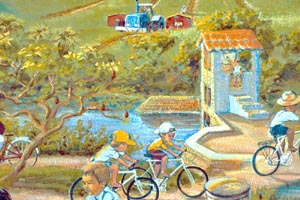 “Since Gaviotas refuses to patent inventions, preferring to share them freely, the design has been copied from Central America to Chile.
“Since Gaviotas refuses to patent inventions, preferring to share them freely, the design has been copied from Central America to Chile.
Electricity comes from a low-head turbine powered by a stream, except in the short dry season, when it is backed up by a diesel generator. ‘In 24 years we’ve learned to cover 70 percent of our food and energy needs,’ says Gonalo Bernal, administrator of Gaviotas. ‘The trees we plant more than compensate for any greenhouse gases we emit. Imagine if the rest of the world lived like us.’
Gaviotas began as a collection of researchers, students, and laborers sharing vehicles, bedding, dishes, clothes - and decisions. In time several of their families joined them and a permanent colony with individual houses emerged. Government was by consensus and unwritten rules. To limit public disorder, alcohol is confined to homes. To preserve wildlife, dogs and guns are banished. A need for police, jail, or door locks has never arisen. Anyone who violates protocol, like a storekeeper who recently admitted to overcharging, is ostracized by the community until his debt is paid. Loafers aren’t tolerated, but with wages above the Colombian minimum wage, plus free meals, medical care, schools, and housing, loafing isn’t a problem.
A techno-tour of the llanos shows how Gaviotas has revolutionized life here. The most significant invention is a simple hand pump capable of tapping aquifers six times deeper than conventional models, but requiring so little effort that children can operate it. In normal pumps a heavy piston must be raised and lowered inside a pipe. Gaviotas engineers realized they could do the reverse; leave the piston stationary and lift an outer sleeve of lightweight, inexpensive PVC tubing instead.”
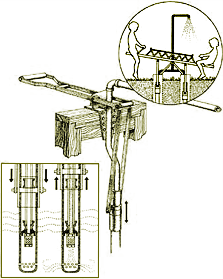 “In the open-air Gaviotas preschool, the children’s see-saw is actually a pump in disguise. As they rise and descend, water gushes from a vertical pipe into an open cement tank. Over the years Gaviotas technicians have installed these in thousands of school yards, using kid power to provide villages with clean water. This simple, inexpensive pump has revolutionised rural life across Colombia for people who used to haul their water in buckets from muddy tropical rivers.” [source]
“In the open-air Gaviotas preschool, the children’s see-saw is actually a pump in disguise. As they rise and descend, water gushes from a vertical pipe into an open cement tank. Over the years Gaviotas technicians have installed these in thousands of school yards, using kid power to provide villages with clean water. This simple, inexpensive pump has revolutionised rural life across Colombia for people who used to haul their water in buckets from muddy tropical rivers.” [source]
“At a windmill-fed cattle trough, surrounded by a sloping cement floor, cowboys have just brought several thirsty calves. As they drink, their dung slides down the slope into a gutter, which sluices it to an enclosed anaerobic fermentation tank, where the cow-pie slurry turns into compost and methane.
The methane flows through pipes to the 16-bed Gaviotas hospital, which a Japanese architectural journal has named one of the 40 most important buildings in the world. It is at once both futuristic and ancient, a maze of angles formed by white walls, glass awnings, skylights, brushed steel columns, and exposed supports trimmed in blue and yellow enamel. The interior is cooled with underground ducts whose hillside intakes face the prevailing breeze. Opposing layers of corrugated roofing create a series of air channels that further bleed away the heat. The combined effect is cost-free, maintenance-free air conditioning. Solar collectors on the roof alternately heat, boil, and distill water. Electricity is from solar photovoltaic cells.
The only hospital within a 12-hour radius, it serves all comers, including both guerrilla and army forces battling in the area. ‘The rule here is never to ask,’ says Bernal. ‘Like the Red Cross, everybody respects us.’
A short, vine-covered walkway connects the Gaviotas hospital to the maloks, a separate wing built by the local Guahivo Indians. Instead of beds, patients and their families lie in hammocks hung from wooden beams under a great thatch roof. Relatives of the sick tend crops of tomatoes, lettuce, and onions in an adjacent hydroponic greenhouse.
If the National University’s pharmacology department and the Guahivo shamans have their way, this greenhouse will one day become the finest medical plant laboratory in the tropics. But money is a critical factor, and Colombia’s expanding, government-owned oil and gas industry has dampened Gaviotas’ solar collector sales by blocking tax benefits for investing in alternative energy. At  the same time revenue from windmills and pumps dropped as Colombian agriculture was battered by an unexpected onslaught of cheap imported foods, the fallout of new free trade policies.
the same time revenue from windmills and pumps dropped as Colombian agriculture was battered by an unexpected onslaught of cheap imported foods, the fallout of new free trade policies.
So Gaviotas has decided to scale down its manufacturing. But no one is getting laid off. ‘Gaviotas isn’t a company,’ Lugari says, ‘we’re a community. In fact the solution means that both employment and Gaviotas will grow.’
The solution is the nearly 20,000 forested acres. In the past 12 years, Gaviotas has planted 1.6 million Caribbean pines (after finding that no indigenous tree would grow on the prairie). To the surprise of foresters, Gaviotans chose not to cut their standing timber. Instead they are converting their windmill factory to process pine resin. Colombia spends $4 million annually to import such resins for the manufacture of paint, turpentine, and paper. Armed with that fact, Lugari persuaded the Japanese government to provide the seed money, via a grant through the Interamerican Development Bank, to begin tapping and processing resin for the domestic market.” [source]
Since the above was written in 1995, the community no longer purhcases diesel fuel and is now totally energy independent. They generate power with turbine engines fueled by the resin of the Carribean pine trees in their forest. These pines are being slowly crowded out by the regeneration of indigenous rainforest. [source]
Other inventions include:
- a high pressure solar cooker
- methane burners
- hot-water solar panels
- parabolic solar grain driers
- self-cooling rooftops
- cooling wind corridors
- corkscrewing manual well digger
- variety of highly efficient and durable windmills
- specialized bicycle for the Llanos
- pedal powered cassava grinder (10 hours work done in 1 hour)
- rotating drum peanut sheller
- ox-drawn land graders
- one-handed sugarcane press
Gaviotas engineers also designed a solar kettle for the hospital. According to engineer Jaime Dávila, “the principle begins with an old country custom: boil water one day to drink the next, after it cools.” Dávila’s goal was an inexpensive solar-operated system that would give unlimited boiled drinking water, already cooled to room temperature, straight from a tap any time of day, and would work under cloudy skies. The kettle took six years to perfect. It combines solar panels, storage tanks, an efficient heat exchanger, a bit of distillation and a spigot — which you turn to draw off potable water.[source]
See some renderings of their solar collectors, solar oven, and wind-powered musical organ.
ISO 14001 Reconsidered
Reader Desmond B. writes:
“Browsing through your site, I was interested by your relatively neutral presentation of the ISO programme. You presented some interesting aspects of the bureaucratic inanities, as well as some of the difficulties of applying euro-centric standards (the symbology not being applicable worldwide) on a global scale. It seems as though there are many positive aspects to the ISO programme (your mention of Toyota’s practices), it appears that there is relatively little citizen/democratic control or oversight of this organisation. It’s one thing to standardise container sizes, but environmental management procedures should perhaps be a more public affair. Curious to see some critical comment from you regarding this, especially considering the frequent mentions of ISO on your site.”
True enough. In my two posts that mention the ISO I was fairly neutral. I was less concerned about democratic accountability of the ISO because the standard setting process is fairly open and decentralized, and standards compliance is entirely voluntary. It is up to governments, not the ISO, to legislate, regulate, or enforce implementation of the standards.
 Standards are developed by consensus of broad-based technical committees and working groups. According to the ISO site:
Standards are developed by consensus of broad-based technical committees and working groups. According to the ISO site:
“In these committees, qualified representatives of industry, research institutes, government authorities, consumer bodies, and international organizations from all over the world come together as equal partners in the resolution of global standardization problems.”
Though the views of these interests are taken into account in the standard development process, only ISO “member bodies” can actually participate in the final vote. A member body of ISO is the national body ‘most representative of standardization in its country’. Only one such body is accepted from each country.
That said, the ISO’s consensus process is becoming less open:
“As part of the streamlining of existing procedures, ISO committees will in future, subject to certain conditions, have the option of dispensing with the committee stage — the part of the ISO process during which national positions are debated in order to reach consensus within an ISO committee — and with the final approval stage, during which the texts of final standards are submitted for formal approval by the full ISO membership.” [source]
The ISO’s patent policy highlights the need for more public participation, accountability, and oversight.
The ISO requires individual or corporation’s holding patent rights on any part of an ISO standard to grant usage rights freely or under “reasonable and non-discriminatory terms and conditions” that apply throughout the world. While this may seem fair, the working committee of the relevant standard determines what is “reasonable and non-discriminatory.” This policy has kept some technical standards out of the public domain and from being implemented in some Free Software projects. For instance, it is impossible to write Free Software which can encode or decode MPEG-2 video or encode or decode MPEG-1 Layer 3 audio in the United States. When the organzation that sets standards for the Internet, the W3C, floated its own draft policy considering “reasonable and non-discriminatory” licensing fees, it was widely condemned in public comment and eventually dropped in favor of a draft with royalty-free licenses.
As Desmond notes, though, environmental management procedures are a different matter from, say, standard paper sizes.
The major requirements of an Environmental Management System (EMS) under ISO 14001 include:
- Issuing a policy statement which includes commitments to prevention of pollution, continual improvement of the EMS leading to improvements in overall environmental performance, and compliance with all applicable statutory and regulatory requirements.
- Identification of all aspects of the community organization’s activities, products, and services that could have a significant impact on the environment, including those that are not regulated
- Setting performance objectives and targets for the management system which link back to the three commitments established in the community or organization’s policy (i.e. prevention of pollution, continual improvement, and compliance)
- Implementing the EMS to meet these objectives. This includes activities like training of employees, establishing work instructions and practices, and establishing the actual metrics by which the objectives and targets will be measured.
- Establishing a program to periodically audit the operation of the EMS
- Checking and taking corrective and preventive actions when deviations from the EMS occur, including periodically evaluating the organization’s compliance with applicable regulatory requirements.
- Undertaking periodic reviews of the EMS by top management to ensure its continuing performance and making adjustments to it, as necessary. [source]
“ISO 14001 does not establish performance requirements or specific criteria and indicators for defining sustainable forestry. Among the misleading practices that ISO wants to put an end to [is]... giving the false impression that... ISO 14000 is a label signifying a ‘green’ or ‘environmentally friendly’ product. This is not so. They are not product standards.” [source]
Nor does the auditing process include public oversight.
“Companies write their own public environmental policies — compliance with these policies, or even compliance with the law, is not a condition of certification. ISO 14001 certifications neither audit nor verify on-the-ground environmental performance. Public consultation is not a requirement of the certification process, nor are public summaries of certification audits required. Because ISO 14001 has no forestry performance standards, any forestry company — from the most environmentally destructive to the most well-managed — can be certified. Contrary to claims by the Canadian Pulp and Paper Association, third party audits to the ISO 14001 standard do not ‘ensure sustainable forestry’.” [source]
Indeed, Greenpeace criticizes the ISO 14001 standard and its use by the Vancouver-based company International Forest Products (Interfor) to “greenwash” its logging operations in old growth rainforests along the coast of British Columbia.
“Weaknesses of the ISO 14001 standard include:
- Compliance with the environmental policy, or even compliance with the law, is not a requirement of certification — the company sets the environmental policy
- ISO 14001 neither sets nor endorses any environmental performance standards, in forestry or in any other industrial sector
- ISO 14001 certifications neither audit nor verify on-the-ground environmental performance
- Public consultation is not a requirement of the certification process, nor are public summaries of certification audits required
- ISO 14001 is not an environmental labeling system
- ISO has no effective controls to prevent misleading marketing claims related to ISO 14001 certifications.
Environmental management system (EMS) certification schemes are completely different from environmental labeling schemes. As the ISO points out, “Two organizations carrying out similar activities but having different environmental performance may both comply with its [EMS] requirements.”
Environmental labeling, on the other hand, requires performance above a threshold. The environmental label is only awarded if a product or service has reached this level. The distinction between ISO 14001 and environmental labeling is essential. Because ISO 14001 has no forestry performance standards, any forestry company — from the most environmentally destructive to the most sustainable — can be certified. An ISO 14001 certification tells the consumer nothing about the relative environmental performance of any company’s, including Interfor’s, forestry operations.” [source] (Emphasis added.)
No Man’s Land, International Park
From the Chicago Tribune, July 26, 2003:
Greening of the Iron Curtain
Gorbachev backs proposal to make border a preserve
“Mikhail Gorbachev, who as Soviet leader presided over the troops and tanks that guarded the Iron Curtain, now wants a nature reserve along the full length of the former Cold War border, from Finland to the Adriatic.
German and other European environmental groups have devised a plan to create nature parks out of the no man’s land that separated the Soviet bloc from the West.
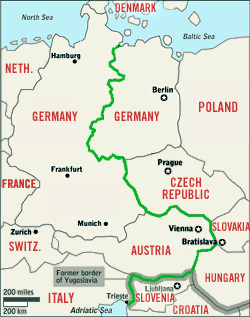 Kept forcibly free of people during more than 40 years of the Cold War, the border between Eastern and Western Europe became a refuge for plants and animals. Construction in the region now threatens these unintentional but important nature reserves, environmentalists fear.
Kept forcibly free of people during more than 40 years of the Cold War, the border between Eastern and Western Europe became a refuge for plants and animals. Construction in the region now threatens these unintentional but important nature reserves, environmentalists fear.
‘Ecology isn’t something we can only leave to politicians,’ Gorbachev, who is president of the environmental organization Green Cross International, said when lending his support to the project at a recent conference in Bonn, Germany.
Although the idea of making parks along former Cold War borders has been around since the fall of the Berlin Wall in 1989, the conference was the first time that representatives of all the border countries had met to discuss the feasibility of having parkland run the length of what was the Iron Curtain.
Plans for the park are furthest along in Germany, where the border between East and West Germany once stretched for 870 miles. A recent study found that 85 percent of the land is still undeveloped enough to be included in a national park.
Plans were delayed while courts determined the status of the land, but most claims are now settled, and the German Finance Ministry recently announced it might be able to donate the 65 percent of former border land still in government possession.
Environmentalists emphasize that the reserve would not simply be the area it covered or the number of endangered species it contained but also that it would link many groups of organisms, known as biotopes, in the longest continuous stretch of undeveloped land left in Central Europe.
In the other former border countries, plans for a park are in only their early phases. The most likely route would be around the eastern half of Austria to the Adriatic, while another area would encompass Albania, whose border with Yugoslavia was always heavily guarded, and would then pass along the northern border of Greece.
Several speakers at the conference observed that Gorbachev — who could have rolled back Eastern Europe’s anti-Communist revolutions by force as his predecessors did — was on hand and had, in effect, made the border park possible.
Steffen Flath, the environment minister of what is now the German state of Saxony, once part of Communist East Germany, turned to Mr. Gorbachev and said, ‘I remember July 1989 when things were starting to bubble, and our government said, “Send us tanks,” and you, Mr. Gorbachev, you didn’t send those tanks.’
With the congratulatory words about vanishing borders in central Europe, however, some of those who follow events in this part of the world feared that events farther east were being ignored. Tamas Marghescu, European director of the World Conservation Union, said nervous states about to join the European Union were creating new divides. He cited what he said was a new impenetrable fence along the border between Poland and Belarus, which he said split an important park that straddles the border. ‘It’s the new Iron Curtain,’ he said.”
The Thayatal National Park, in Austria, and the Podyji National Park in the Czech Republic already exist along the river known in Austria as the Thaya, and in Czech as the Dyje, a former boundary of the Iron Curtain. [more]
via Planetizen


